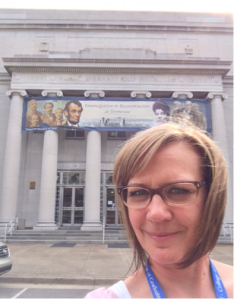— post by Susan London-Sherer, Historical Archaeology/Historic Preservation Graduate Intern
As MTSU’s first Public History graduate student to pursue an internship in historical archaeology, I must admit, I feel like a trailblazer. As it turns out, I am not the only trailblazer to have spent some time toiling away in the hot sun at Magnolia Valley. Last week, one of our excavation units in Area A revealed a long-hidden secret. The field school students who began the excavation quickly found themselves shoveling what appeared to be uniform-sized rock, and lots of it! A very curious find indeed, in the middle of this lovely pasture. As the excavation moved along, it became evident that the feature we were uncovering closely resembled a road. With this information in mind, my next step was to do research on some of the earliest roadways in the College Grove and Allisona areas, and to try to discover who built these roadways, and for what purpose. There is no better place to research Tennessee history than at the Tennessee State Library and Archives in Nashville.
With the help of some great people, I have been able to uncover some fascinating details about the property over the past few weeks. Steve Rogers at the Tennessee Historic Commission helped me to discover that this property was once part of a 1784 North Carolina land grant in the amount of 5000 acres to Hardy Murfree, Lieutenant Colonel of the First Regiment of the North Carolina Continental Line. Land grants were regularly given to families of soldiers who fought in the Revolutionary War. A standard amount that appears over and over in the records is 640 acres, exactly one square mile. Other American patriots were also gifted with land grants, and some began selling off their land without every having laid eyes upon it. Robert Nelson began selling some of his land in 1788. John Topp bought some this land and eventually sold it to William Ogilvie and James Allison. These were some of the earliest documented people to have owned land in the College Grove/Allisona area. In 1793, David and William Wilson appear in the deed books, receiving land grants for 640 acres and for 2,000 acres.
With early settlers coming to the region, setting up homesteads and farms, roads would most certainly have become a necessity by the early 1800s. Jay at the Tennessee State Library and Archives helped me fill in some of blanks by leading me to some excellent sources about early Tennessee roads. Route 31A, also known as Henry Horton Highway, is one of the oldest traveled thoroughfares in Middle Tennessee. It is believed to follow a route similar to an ancient Native American trail that connected with the Ohio River in Kentucky and then moved southward past the Tennessee River, and into the Huntsville, Alabama area. According to William N. Lloyd’s article in the Marshall County Historical Quarterly (Winter 1973), “The first white men coming through Middle Tennessee identified the primitive path as the trail to the Fishing Ford.” The Ford was just south of modern-day Chapel Hill near where the 31A bridge crosses the Duck River today. Lloyd wrote, “northern and southern Indian tribes used the trail in commerce and war with each other, as well as to travel to the fantastic neutral hunting ground in Tennessee for major sources of meat.”
The exact route that the trail to Fishing Ford followed through Williamson County is not well documented, but the trail appears to have come through the present-day College Grove area and relatively close to our site.
Soon after Williamson County was formed in 1799, county officials began working on public roadways by cutting and clearing old Native American Trails. This marked the first of three distinct stages of road building that developed the Fisher Ford trail into the modern thoroughfare that it is today. The second stage was the turnpike era of the mid-1800s, and third was the state road-building era of the early 1900s. Throughout the time period 1807-1809, the county court appointed local men to construct a road from James Allison’s property in present-day Allisona toward the Fishing Ford. Among the men appointed were three of the Wilson brothers, Aaron, James, and Zaccheus, along with John Ogilvie and George Allison, some of the earliest settlers to the region. Beginning in 1810, the court appointed various men to oversee the operation and maintenance of the road that had been built.
I am still researching whether or not James Allison ever owned the 372-acre property that our site occupies. Currently, there is a gap in the deeds from our original land grant of 1784 until 1836 when James B. Russell sold the first 460 acres of land to the man we once thought was our original property owner, Mr. William McDowell. Obviously, there is a lot more to the story that still needs to be uncovered. Could the section of road in our excavation unit possibly be related to the 1807 court appointed road that began on James Allison’s property? How many times did the property change hands in the 50 years that still remain a mystery to us? Perhaps the discovery of a long-forgotten road, buried deep beneath layers of dirt and time in a farm pasture, has the ability to open up new avenues of discovery. At some point in time, people blazed a trail across present-day Allisona, across the property that we are now searching for clues to the past. Over the next few weeks, we will tirelessly continue to follow the trail.


